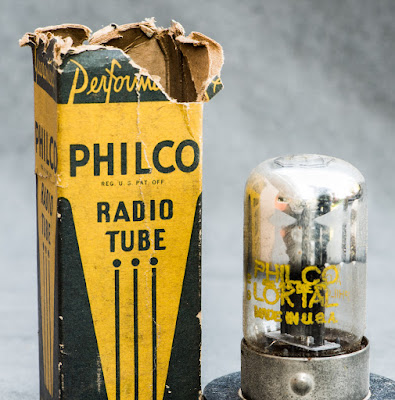After the presentation of the 7B4 last month, let's continue the Loktal theme with the 7A4.
As mentioned in last months post, being electrically equivalent to the 6SF5, the 7B4 could be used as the first tube in the Octal Phono Preamplifier. The 7A4 is the Loktal equivalent of the 6J5. So with the 7B4 and 7A4 combination a Loktal Phono preamplifier could be built.
 The 7A4 shares the same pinout with the 7B4. But that's where the similarity ends. The 7A4 has a much lower mu of 20 combined with a plate resistance around 7kOhm. Like the 6J5 it is basically one system of the 6SN7 or 7N7 which is the 6SN7's Loktal equivalent. For complete technical details refer to the Tung-Sol data sheet. With these technical parameters the 7A4 is a quite versatile tube, fitting for many applications. Besides the mentioned phono stage it could be used in line stages and also as driver for output tubes in power amps. Like all other Loktal types, the 7A4 was only made by a few manufacturers and most of them came from Sylvania. While researching information about the 7A4 I came
The 7A4 shares the same pinout with the 7B4. But that's where the similarity ends. The 7A4 has a much lower mu of 20 combined with a plate resistance around 7kOhm. Like the 6J5 it is basically one system of the 6SN7 or 7N7 which is the 6SN7's Loktal equivalent. For complete technical details refer to the Tung-Sol data sheet. With these technical parameters the 7A4 is a quite versatile tube, fitting for many applications. Besides the mentioned phono stage it could be used in line stages and also as driver for output tubes in power amps. Like all other Loktal types, the 7A4 was only made by a few manufacturers and most of them came from Sylvania. While researching information about the 7A4 I came across an interesting special tube series designed by Philco. The 'XX' series. This series consisted of the XXB, XXD, XXFM and XXL with the latter being a near equivalent of the 7A4. I found a Tung-Sol data sheet of the XXL. Although often listed as technically identical this data sheet shows a slightly higher plate resistance and also a variation of the amplification factor over the operating points. Nevertheless the two types were regarded as close enough electrically so that many 7A4 tubes also carry the XXL designation. I couln't find much information about the Philco XX tubes and the reasoning behind them. Might just have been a marketing stunt. If anybody has some background information about this, please share.
across an interesting special tube series designed by Philco. The 'XX' series. This series consisted of the XXB, XXD, XXFM and XXL with the latter being a near equivalent of the 7A4. I found a Tung-Sol data sheet of the XXL. Although often listed as technically identical this data sheet shows a slightly higher plate resistance and also a variation of the amplification factor over the operating points. Nevertheless the two types were regarded as close enough electrically so that many 7A4 tubes also carry the XXL designation. I couln't find much information about the Philco XX tubes and the reasoning behind them. Might just have been a marketing stunt. If anybody has some background information about this, please share.As always, let's start with a look at the plate curves of the tube:
A nicely linear set of curves. Actual curves are just as good:
Now let's look at some 7A4 tubes. Here we have a Sylvania:
Corrosion of the base is quite common with Loktal tubes and probably one of the reasons why they are not really popular.
A Philco.
This one is marked XXL on the top.
Another 7A4:
This time with dual marking 7A4 and XXL:
This marking was not consistent. Sometimes the box would be marked 7A4 while the tube inside only had the XXL marking.
A National Union 7A4 in beautiful, pristine box.
The base which also omits two of the unused pins as the 7B4:
Sylvania 7A4 tubes:
JAN (Joint Army Navy) tube:
Another military 7A4:
Interesting note on the boy: 50 Hr. Life guaranteed? I can't imagine the 7A4 had such a short lifespan. Maybe this was for some particular critical application? Again if anybody has some more information about this, please share.
Here we have a General Electric tube:
This was of later manufacture and does not have the characteristic large getter area as most other Loktal tubes.
Here an older GE:
The two different GE 7A4 side by side:
Tung-Sol:
Some Philco 7A4s:
Here we have a case of 7A4 marking on the box but XXL on the tube:
Another style box:
And lastly more from Sylvania:
Like the 7B4, the 7A4 does not give much of a light show when turned on:
Let's examine the internals of this one:
Glass removed:
The plate is quite thin in diameter:
The triode system detached from the base:
The heater:
The plate removed, unlike the 7B4 it has an oval shape.
Grid and cathode:
The cathode by itself:
In the close up it can be seen how coarse the cathode coating is:
The grid:
I hope you enjoyed this presentation of the 7A4 and maybe some tube amp builders will get inspired to use it instead of the 6J5 to give this almost forgotten tube some use.
Best regards
Thomas






















































